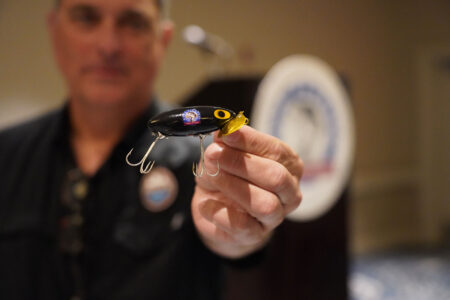The 2020 American Shad Benchmark Stock Assessment and Peer Review Report indicate American shad remain depleted on a coastwide basis. Multiple factors, such as overfishing, inadequate fish passage at dams, predation, pollution, water withdrawals, channelization of rivers, changing ocean conditions, and climate change are likely responsible for shad decline from historic abundance levels. Additionally, the assessment finds that shad recovery is limited by restricted access to spawning habitat. Current barriers partly or completely block 40% of historic shad spawning habitat, which may equate to a loss of more than a third of spawning adults. The “depleted” determination was used instead of “overfished” because the impact of fishing on American shad stocks cannot be separated from the impacts of all other factors responsible for changes in abundance. The benchmark assessment was endorsed by the Peer Review Panel and accepted by the Shad & River Herring Management Board (Board) for management use.
“On behalf of the Board, I want to commend the members of the Shad Technical Committee and Stock Assessment Subcommittee for their outstanding work on the 2020 Benchmark Stock Assessment Report,” stated Board Chair Dr. Michael Armstrong from Massachusetts. “This is a considerable body of work that substantially advances our understanding of the challenges facing American shad stocks along the Atlantic coast. It certainly has given the Board a lot to think about regarding next steps in management to improve population resiliency. Given the stock-specific nature of shad management, the Board has tasked the Technical Committee with identifying potential paths forward to improve shad stocks along the coast considering the assessment results.”
Coastwide adult mortality is unknown, but was determined to be unsustainable for some system‐specific stocks, indicating the continued need for management action to reduce adult mortality. Specifically, adult mortality was determined to be unsustainable for three stocks – Connecticut, Delaware, and Potomac – and sustainable for five stocks – Hudson, Rappahannock, York, Albemarle Sound, and Neuse (see table on page 2 for information by system). The terms “sustainable” and “unsustainable” were used instead of “not overfishing” and “overfishing” because fishing mortality cannot be separated from other components contributing to total mortality. Though adult mortality was determined to be sustainable for some system‐specific stocks, it is important to note that maintaining sustainable adult mortality will not result in favorable abundance status if juvenile mortality is unsustainable. Unfortunately, juvenile mortality status cannot be determined due to insufficient data collection in all systems; without these determinations, significant uncertainty remains in assessment advice for management of American shad. Thus, the recovery of American shad will need to address multiple factors including anthropogenic (human-caused) habitat alterations, predation by non‐native predators, and exploitation by fisheries. The assessment also highlights the need for stock composition monitoring data in order to separate the impacts of fishing from other factors driving American shad population dynamics in future stock assessments.
In evaluating the stock assessment, the Peer Review Panel stated, “It is noteworthy that the amount of new data, particularly following recommendations of the last benchmark assessment, and the level of new analyses takes the assessment up a significant level from prior benchmarks, and reflects a culmination of understanding of the species and attempts to manage it.” Further, the Panel noted two systems (Potomac and Albemarle Sound) had sufficient data for use in data-rich statistical catch-at-age models and, for the first time, a coastwide habitat assessment of continental waters was undertaken, with specific reference to dams and passage as impediments to sustainable stocks. Finally, the Panel stated, “there is growing recognition that the suite of in-river predators on juvenile shad is shifting, due to introductions/invasions of non-native species such as various catfishes, pike, black bass, snakeheads, etc. Predators can have a disproportionately large impact on year class success when fish populations are at such low levels, as is currently the case, threatening resilience.”
A more detailed overview of the stock assessment, as well as the Benchmark Stock Assessment and Peer Review Report will be available on the Commission website, www.asmfc.org, on the Shad and River Herring webpage under stock assessment reports. For more information, please contact Caitlin Starks, Fishery Management Coordinator, at cstarks@asmfc.org or 703.842.0740.




